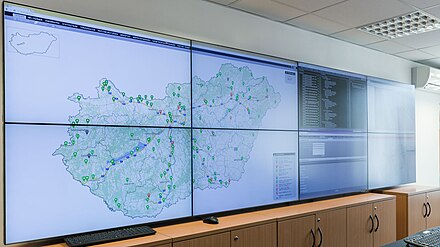
An intelligent transportation system (ITS) is an advanced application that aims to provide innovative services relating to different modes of transport and traffic management and enable users to be better informed and make safer, more coordinated, and 'smarter' use of transport networks.[1]
Some of these technologies include calling for emergency services when an accident occurs, using cameras to enforce traffic laws or signs that mark speed limit changes depending on conditions.
Although ITS may refer to all modes of transport, the directive of the European Union 2010/40/EU, made on July 7, 2010, defined ITS as systems in which information and communication technologies are applied in the field of road transport, including infrastructure, vehicles and users, and in traffic management and mobility management, as well as for interfaces with other modes of transport.[2] ITS may be used to improve the efficiency and safety of transport in many situations, i.e. road transport, traffic management, mobility, etc.[3] ITS technology is being adopted across the world to increase the capacity of busy roads, reduce journey times and enable the collection of information on unsuspecting road users.[4]
- ^ Mahmood, Adnan; Siddiqui, Sarah Ali; Sheng, Quan Z.; Zhang, Wei Emma; Suzuki, Hajime; Ni, Wei (June 2022). "Trust on wheels: Towards secure and resource efficient IoV networks". Computing. 104 (6): 1337–1358. doi:10.1007/s00607-021-01040-7. ISSN 0010-485X. S2CID 246434811.
- ^ DIRECTIVE 2010/40/EU OF THE EUROPEAN PARLIAMENT AND OF THE COUNCIL of 7 July 2010. eur-lex.europa.eu
- ^ "Reducing delay due to traffic congestion. [Social Impact]. ITS. The Intelligent Transportation Systems Centre and Testbed". SIOR, Social Impact Open Repository. Archived from the original on 2017-09-05. Retrieved 2017-09-05.
- ^ "Smart tech to end fwy congestion". PerthNow. 2020-07-07. Retrieved 2020-10-07.